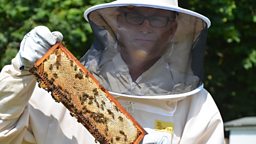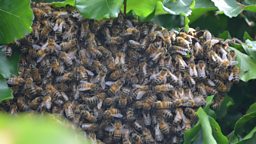Main content
The buzz about bees
From honey to the bees 鈥� learn more about the remarkable secrets of the most iconic insect of the British summer.
Four super sweet honey facts
- Worldwide, honey bees provide an annual honey crop of approximately one billion kilograms
- Each honey bee will produce about a twelfth of a teaspoon of honey in its lifetime 鈥� probably the amount left on your knife after spreading honey on your toast
- 10 million foraging trips go into making one jar of honey, a distance of up to 50,000 miles 鈥� that鈥檚 equivalent to travelling twice around the globe!
- Honey has a virtually eternal shelf-life if kept sealed and apparently honey found in the pharaohs鈥� tombs in Egypt was still edible after 3,000 years

It takes 10 million foraging trips to produce one jar of honey

Chris Packham learns what it takes to be a beekeeper
10 things you need to know about the honey bee
- A forager bee may visit 2,000 flowers a day to collect nectar and pollen
- The bees鈥� stomach is the size of a pinhead and to fill this once the bee may need to visit 100 flowers
- Bees fly at an average of 13 to 15 mph and can travel up to four miles away from their hive 鈥� sometimes more
- Bees also eat pollen and an average bee hive or colony consumes around 40 kilos a year
- A bee flaps its wings between 200 and 230 times per second when flying
- Each bee flies about 500 miles in its lifetime and if it is not eaten by a predator, the bee usually dies of exhaustion after about three weeks
- Any fertilised egg could turn into a queen rather than a worker and being fed royal jelly triggers this transformation
- Honey bee senses are impeccable: they can see ultraviolet light, have an amazing sense of smell, can detect electrical signals and the earth鈥檚 magnetic field
- Honey bees can count up to four and memorise landmarks to help them to learn where their hive is located
- The cells in a natural honey bee comb are initially circular but gradually take on the familiar hexagonal shape by a flow of the wax, which is turned semi-molten by the heat from specialist heater worker bees

Forager bees visit up to 2,000 flowers a day

An average beehive consumes 40 kilos of pollen a year
